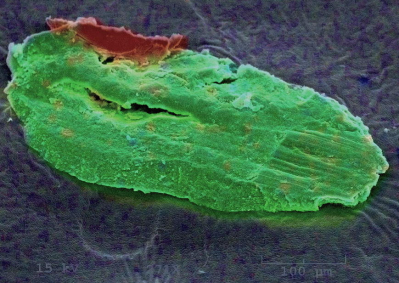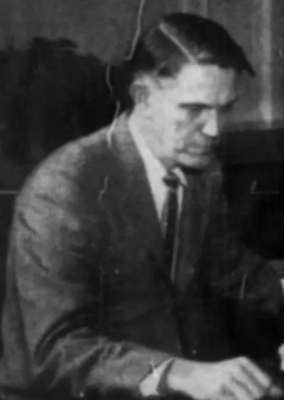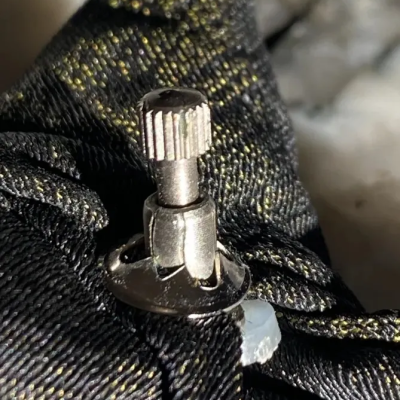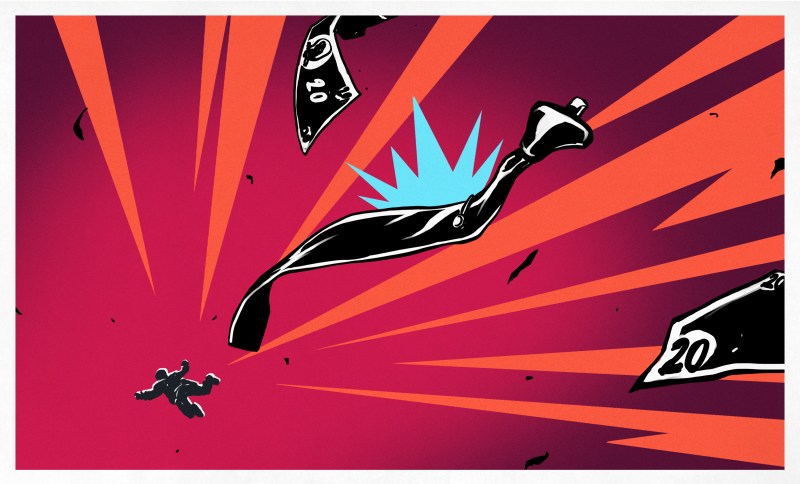It’s one of the strangest unsolved cases, and even though the FBI closed their investigation back in 2016, this may be the year it cracks wide open. On November 24, 1971, Dan Cooper, who would become known as DB Cooper due to a mistake by the media, skyjacked a Boeing 727 — Northwest Orient Airlines Flight 305 — headed from Portland to Seattle.
During the flight, mild-mannered Cooper coolly notified a flight attendant sitting behind him via neatly-handwritten note that he had a bomb in his briefcase. His demands were a sum of $200,000 (about $1.5 M today) and four parachutes once they got to Seattle. Upon landing, Cooper released the passengers and demanded that the plane be refueled and pointed toward Mexico City with him and most of the original crew aboard. But around 30 minutes into the flight, Cooper opened the plane’s aft staircase and vanished, parachuting into the night sky.
In the investigation that followed, the FBI recovered Cooper’s clip-on tie, tie clip, and two of the four parachutes. While it’s unclear why Cooper would have left the tie behind, it has become the biggest source of evidence for identifying him. New evidence shows that a previously unidentified particle on the tie has been identified as “titanium smeared with stainless steel”.
The Ties That Bind
Scientist Tom Kaye analyzed Cooper’s tie in 2013 and discovered thousands of particles, including high-grade stainless steel, aluminium, and titanium, among other rare elements. These particles are believed to be linked to the aerospace industry, which would go a long way in explaining how a titanium particle could have ever been abraded with 400 series stainless steel in the first place.

Devoted DB Cooper investigator and researcher Eric Ulis, who has been studying the case for decades, determined that the particle came from the cold rolling process in which a sheet of titanium or other metal is thinned between two rollers at an extremely high pressure to enhance the metal’s strength.
Although cold rolling is common today, that wasn’t at all the case in the 1960s. Ulis believes that the particle places Cooper as an employee of a special metals facility in Pittsburgh called Crucible Steel, who were a major supplier to Boeing in the 60s and 70s.
This proposition is not exactly news — it has long been believed that Cooper had ties to the aerospace industry due to his use of aviation jargon throughout the heist, and at least enough knowledge of the Boeing 727 to open the aft staircase. The particle is nonetheless quite significant according to Ulis, who said that Crucible was one of few places where titanium was being cold-rolled in the 1960s, and they held two patents for the kind of titanium identified in the particle.
A Grain of Salt

In late 2022, discovery of other elements by Tom Kaye led Ulis to a new suspect, Vince Petersen, who had been one of only eight engineers employed at Crucible in the years preceding the skyjacking. All eight of them wore ties to work, and their assistants did not.
Petersen was identified as a suspect after Ulis and his team combed through a spreadsheet of over 100,000 particles looking for anything out of the ordinary. That’s when the tens of thousands of particles linked to the aerospace industry were discovered.
Another interesting particle found on the tie was a trace of a commercial type of salt. Per Ulis’ research, Petersen was quite studied and even wrote an academic paper on the effects of salt on titanium. Unfortunately, Petersen died in 2002.
So, What’s Next?
The only other shred of evidence tied to the skyjacking showed up in 1980 when a young boy was digging on the banks of the Columbia River in Washington state and found $5,800 in twenties. The serial numbers match those of the bills given to Cooper, but no new leads were formed. In the years that followed, the FBI looked at 800 potential suspects.

For Ulis, the only option is to gain access to the actual tie. In 2023, he sued the FBI in order to force them to release the tie for further testing. But a judge recently dismissed his case, citing that the Freedom of Information Act pertains only to records and not to tangible objects such as ties. Ulis intends to appeal the ruling, and says he is working a couple of other angles to gain access to the tie and look closer than before for DNA samples.
Ulis believes that the FBI overlooked a feature of the tie — a small clasp in the knot that allows the user to adjust the knot’s size. Ulis’ theory is that if Cooper ever adjusted this, his DNA would be trapped in the grooves. Ulis came upon the clasp after poring over the patent for the tie, which was sold by JC Penney. Recently, Ulis asked two former FBI investigators if they were aware of this feature of the tie at the time, and they said they were not.
And although the FBI closed the case almost a decade ago, Ulis refuses to give up, confident that the case will be solved in a matter of years.

















Of course, a tie could always have been donated away or sold at a garage sale. Not to say that this avenue is the wrong one either.
If it were proven that was him it would open up even more interesting questions.
We know some ended up in the woods. Did he lose all the money? Did he just go home empty handed? If so was that his intent in the first place, just dump it all as a stunt to make the airline lose money or did it come untied or something?
Or did he manage to hold on to most of it. Did he just go back to his normal life and refrain from spending too much too fast so that no one noticed anything was off? If he did spend it how did none of it ever get discovered by it’s serial number?
That all seems stranger to me than the mystery of his identity. With him being dead… maybe no one can ever know.
The unwillingness of the FBI to participate makes me think they (A) figured it out and (B) are unwilling to say anything that might divulge how they figured it out. My best guess would be that they traced the money back. Nearly trivial today, not impossible back then.
Something is causing the FBI to supress this story, my guess is unbelievable bad press resulting from the actual incident/ people involved and their failures to prevent that.
There is no way that a decades old hijacking of minimal importance even then could be as bad for the FBI as any of the myriad fuckups that happened on their watch in between trying to pressure MLK to kill himself and not noticing Arab dudes looking to learn to fly airliners but not land them. I would be absolutely *gobsmacked* if the FBI were suppressing the story vs just not giving a shit.
Good point…
That’s assuming it wasn’t taken out of the country right away and laundered using foreign currency. The actual money might be in some bank vault in Hong Kong right now, and whoever spends it won’t tell you where it came from.
Today I would not be surprised in any way at all if every single note of currency, in most countries, around the globe had their serial number scanned and permanently recorded when entering or leaving the banking system. And I’m sure that the individual serial numbers can now be retroactively traced back through their full banking lifespan back to when and where they were minted.
But the question in my mind would be how long ago could technology like this have existed ? The there requirements, in my mind, would be mass storage, light sensitive senors that could rapidly differentiate the numbers from zero to nine and letters A to Z on the notes, and some very basic processing. 1980’s ? 1970’s ? Earlier ?
That’s a fun thought challenge and it’s bit difficult to find pre-internet info via internet search. It FEELS like it it’s feasible with the same tech used to differentiate bill denominations or auto-reject. So skip past any ATMs that use deposit envelopes. “Electronic Journal” is the feature name, maybe you can find it in patents. I should just ask my mom when ATMs were capable of auto-rejecting bills.
https://hackaday.com/2023/09/20/youve-got-mail-reading-addresses-with-ocr/
OCR technology was conceived of in the 1870’s, and it became technically feasible between 1930-50. The first real applications came out in 1954 when Reader’s Digest started digitizing sales reports into punched cards, according to Wikipedia.
Banknotes are printed not minted, but you do bring up an interesting point. Are coins serialized? It wouldn’t be too hard to create some kind of subtle serial numbers on the coins, especially on higher value ones.
Modern laser serial number 3tching could mark coins.
The problem is that small or obfuscated markings are going to get destroyed quickly if a coin is handled, or when it is stored.
It makes sense for something like a $100 gold coin.
It makes no sense for any coin being circulated.
Before laser etching was a normal thing? No.
Not a chance for anything produced in any volume.
It would be more effort to mark the coins than to strike them.
My father was using an OCR reader for programming IBM mainframes in the late 1960s. He would hand write an RPG II program on special paper forms, following a very specific character writing style. The OCR scanner read his handwriting and punched a deck of cards. He’d proofread the cards, and then he could submit the deck.
So the technology for reading machine embossed serial numbers, which are probably more legible than handwriting, would have been available in the 1960s.
But we know banks of the era did not routinely scan bills. Tellers constantly moved bills into and out of cash drawers as a normal part of business, accepting deposits, making change, issuing withdrawals, etc. So a bill that was deposited into the till at 9:00 AM could have been handed out to the next customer as change by about 9:05 AM. It’s possible that bills given to a hijacker could have been marked with something special like UV ink, but tellers of the era didn’t normally check bills under UV lamps or with automated counterfeit detectors like they use today.
However, it’s certainly possible tellers might have been given a list of hot serial numbers where they could look up suspected bills. Getting a crumpled $20 might not have raised an eyebrow, but being presented with a stack of brand new Benjamins might have caused a teller to check such a list.
I suppose it’s possible the Federal Reserve Banks (central banks that serve commercial banks as their customers) could have scanned incoming bills, but they normally only processed worn bills at the end of their lives, slated for destruction. If they scanned them (which I don’t know if they did) about all they could have done was identify a bill that was found on a hot list, and which branch had accepted it. And they probably wouldn’t have been able to identify which bank customer had deposited a particular bill, so they would have had to manually review the bank’s film one customer at a time, looking for suspects. But wherever the bill traveled between the hijacker and its final acceptance bank would have been completely undocumented.
You are seriously underestimating the cost of computing in the pre-internet era. How would get a list of bills to compare against? How would you store the list – on punch cards? With mailing out new sets of punch cards each month? Let’s say you only had 32k words of memory, could you even keep the list in memory?
Depending on which year you’re referring, having a disk drive to store the list would be $10K, $100K, $1M or impossible since it hadn’t been invented yet.
And, you’d have to send each bill to the central bank office that had the computer – regular banks did not have computers until the 1980s. I never worked in banking, but I’m pretty sure it was all on paper and keypunched into a computer later. There is a reason banks used to close at 3pm – so they could do all the paperwork.
As I understand it, the clerks responsible for that after-hours work could not leave until everything balanced properly. They had mathematical techniques such as “casting out nines” to help find errors.
More likely institutional inertia and/or money. The case is officially closed, they don’t want to be bothered with re-opening it. Re-opening it means spending money.
Agreed. Sometimes the government conspiracy is just the bloated nature of government, and sometimes also just the unwillingness for action. Proposals would need to be drawn up, discussions held in meetings, action plans, allocation/assignment of personnel, argued about in budget reviews… and that’s before it gets to office politics.
Re: spending money
Strange for the US government to show concern over spending money.
The US government may not be concerned about /allocating/ money, but the individual agencies /are/ concerned about spending what they get.
Because that’s not really what the FBI is meant for anymore.
Dan Gryder over at the Probably Cause youtube channel already solved this.
Probable Cause
Since I do not want to watch two documentaries totaling 4 HOURS, how about some spoilers, like who does he claim is the perp?
+1
Richard Floyd McCoy Jr.
Does that mean anything to you?
I only watched the 1st video. Incredibly interesting and explains why the FBI covered up their mistakes from the 1st hijacking – after he did it again 5 months later and that’s when he got caught.
50 years later and nearly no one knows that there was a 2nd hijacking ($500,000)
50 year mystery. I saw a 10min youtube documentary I know the truth.
Never change internet.
One episode was 3 hours long. Did you even bother watching the interviews and extensive interviews with the family members? That was just one episode. There are 2 episodes total and a 3rd on the way. It was way more than just 10 minutes. What’s wrong with you?
Extensive interviews and evidence. Brain fart…sorry.
My assertion is that a dude with clear financial incentive to assert his genius success might be skipping over details that hinder his claim or otherwise embellishing his success.
In general documentaries are not trustworthy as far as you can throw them. Some do a good honest job portraying the story but most will skip over things. The Jinx is a great example of a documentary that claimed to solve the case “Killed them all of course” right up until it went to court and the truth came out that they edited things to portray a false narrative.
Did you watch the videos? Dan isn’t in it for the money although the money does help. If you watch his documentary, you might at the very least be moved into the realm of plausibility.
If he was right, he would have published the results somewhere else than Youtube.
Considering Boeing jets are currently in the habit of losing entire doors, it’s more likely that the grain of metal came from the plane he jumped from.
I don’t understand. When you ask a car manufacturer for a convertible, you have to pay extra for it.
Here Boeing never asked for more money and delivered a convertible for the same amount. Why criticizing an elegant commercial advantage? It’s not like this door was useful at first, isn’t it?
the grain of Ti was identified as pure Ti, not an alloy, so it’s not likely that it was used in a plane.
DB Cooper was Walter Reca. Why do they keep raking over this case. Watch DB Cooper : The Real Story. Walter knew very intricate details of the high jacking even down to when he landed he states “I hit the only dead f**king tree in the forest” subsequently breaking his ankle. It even shows the dead tree in the documentary ans its right in the zone where they predicted he jumped.
Ah, the legend. Who doesn’t love a gentleman thief? I hope they never figure it out.
Well unfortunately the most likely explanation is that D.B. Cooper and his money are fertilizing trees in the Pacific Northwest since he died on impact.
Party pooper!
Did no one see what this guy looked like?
Nah. He wore a rubber mask of a dead president…
Well yeah sure but the big question remains open – DID HE SURF…?
https://www.youtube.com/watch?v=VYoKUZ54K5Q&list=OLAK5uy_nKL-Oc5s2ICPBp8bMXJ6aYhIIeFrZGNUo&index=5&ab_channel=NadNeslo-Topic
“Ulis believes that the particle places Cooper as an employee of a special metals facility in Pittsburgh called Crucible Steel, who were a major supplier to Boeing in the 60s and 70s.”
Wait, crucible steel PA, as in, CPM? *checks pocket* Yeah i got some of that in my pocket right now and a bunch of CPM steel at home.
https://www.crucible.com/Products.aspx?c=18
For me this case is interesting as there are no victims.
Years ago, I saw bank robbers. Not that I knew that at the time. There was a bank inside a large train station. There was major construction going on with a complete redesign of the train station which was pretty much entirely removed and replaced while staying open for passengers. The businesses inside the station closed shop for several months during the construction. During the summer, construction companies here have set summer holiday dates. On Friday, it was the last day before summer. The construction company left. On Monday morning, the bank robbers arrived in construction outfits and started to work, doing the same job as the actual construction company. Meanwhile, others in their crew were working on opening the vault. After opening it, they put the cash inside their wheelbarrows, put junk from demolition of walls on top of it, put it in their vans, and repeated until the safe was empty. Took them almost 3 weeks. After that, the real construction company came back and continued the work. A month or two later, the bank employees got back and found an empty safe. As far as I know, they have never been found.
Where did that bank robber happen?
Hollywood also would to like more about it.
Actually, whoever lost money is a victim.